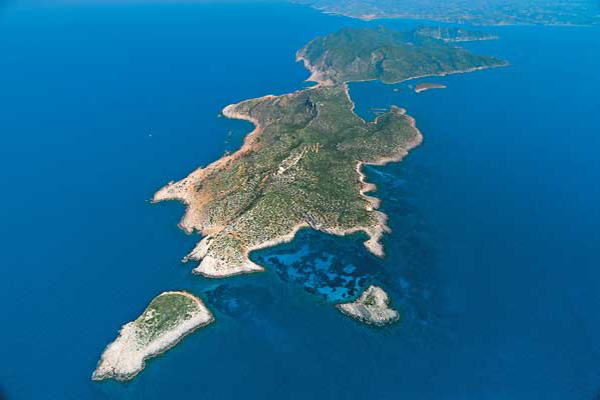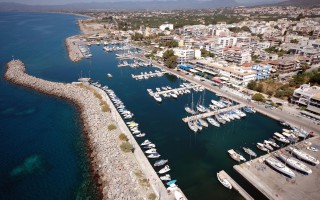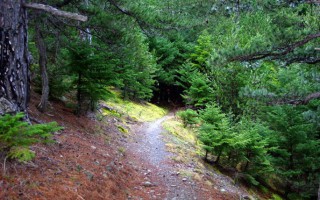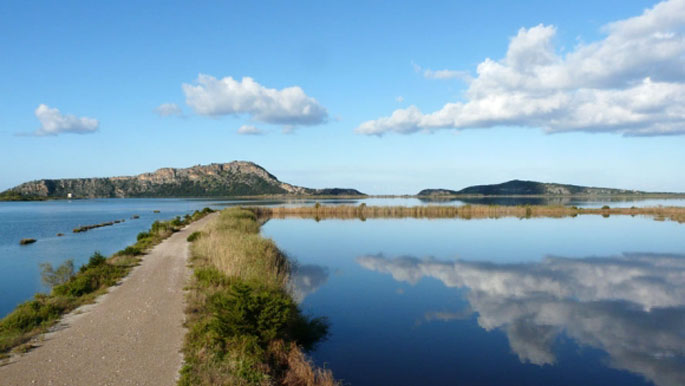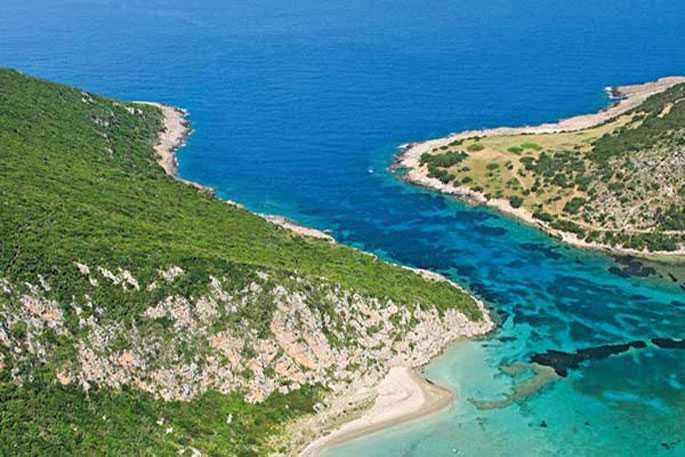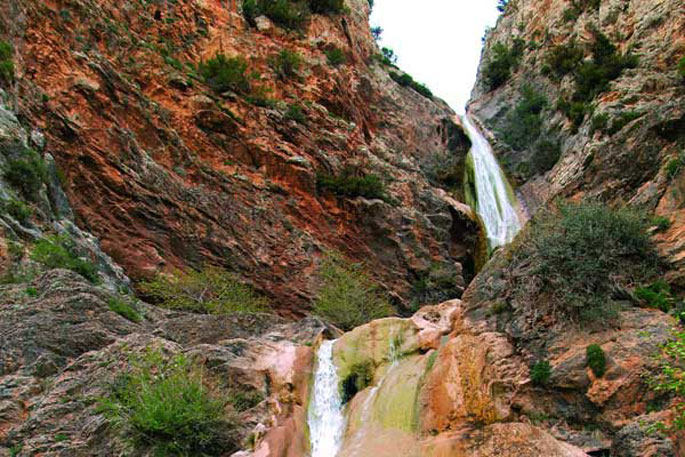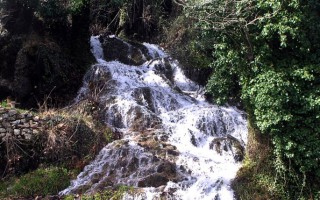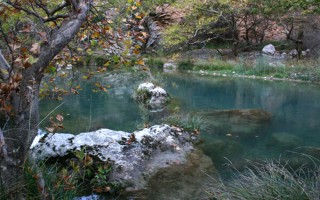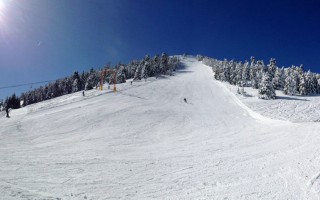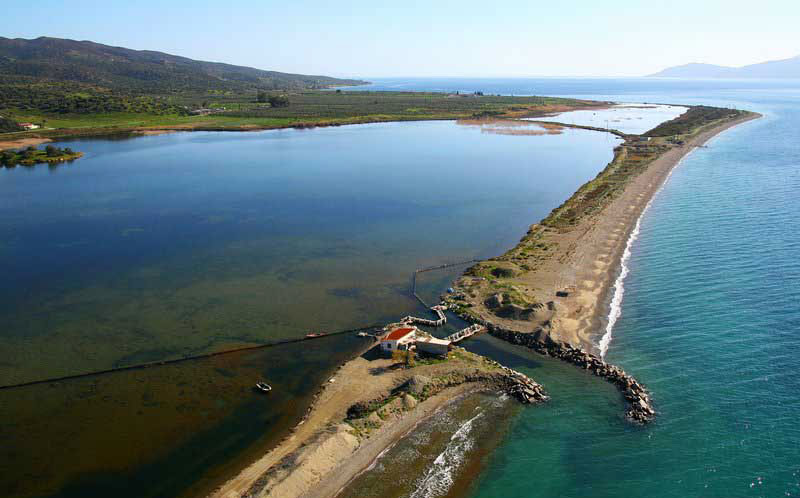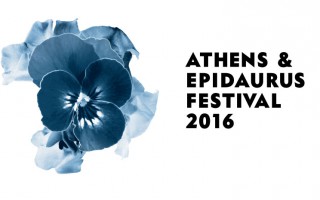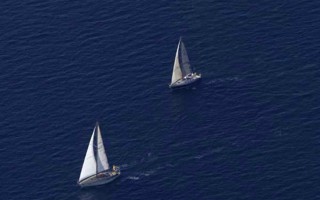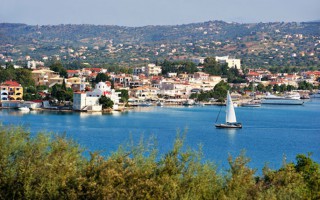Sapientza is an islet of the Messinian Oinousses cluster and is the second biggest after Schiza. It’s an island with lush vegetation, a rare flora and a total area of 9 square kilometres. In 1986, Sapientza was declared as a “listed natural monument” and it was included in the European Network Natura 2000, together with the neighboring Schiza and the area around cape Akritas.Sapientza in Italian means “wisdom” and, indeed, nature here has revealed all its wisdom. In the center of the island there is a huge area covered with typical Mediterranean vegetation of perennial broadleaf weeds, which however don’t have the usual shape of a bush, but they are trees that surpass 10 meters in height! The fauna of the island is equally interesting and includes the famous Kri-Kri (wild goats) that live here in large herds, as well as wild sheep and many species of birds.
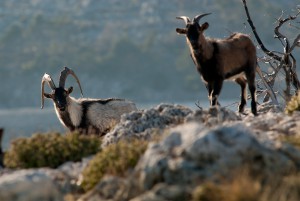 The islet of Sapientza is located off the southwest shores of Messinia, across from Methoni, and is one of the 7 islands that form the cluster of the Messinian Oinousses. Historically, Sapientza was claimed by many, due to its strategic location -at the crossroads between Italy and the Middle East-, as well as due to its safe harbor. In 1209 it fell into the hands of the Venetians and many centuries later, after the liberation of Greece from the Turks, it was returned to the Greeks. It was claimed by the British, as part of the Ionian Islands between 1847 and 1850, during the notorious “Don Pacifico Affair” that was a conflict between Britain and Greece.
The islet of Sapientza is located off the southwest shores of Messinia, across from Methoni, and is one of the 7 islands that form the cluster of the Messinian Oinousses. Historically, Sapientza was claimed by many, due to its strategic location -at the crossroads between Italy and the Middle East-, as well as due to its safe harbor. In 1209 it fell into the hands of the Venetians and many centuries later, after the liberation of Greece from the Turks, it was returned to the Greeks. It was claimed by the British, as part of the Ionian Islands between 1847 and 1850, during the notorious “Don Pacifico Affair” that was a conflict between Britain and Greece.
Porto Loggo is the harbor of Sapientza and is a well-protected cove. A trail starts from there, leading to the famous lighthouse of the island, which is an impressive British construction of 1890 with a spectacular view. The famous, unique in Europe, perennial broadleaf forest dominates the center of the island in an area of 240 square metres. This forest was basically the reason the islet was declared as a “listed natural monument” and included in the European Network Natura 2000. The rarity of this forest is that its broadleaf weeds surpass their standard height, creating dense vegetation, which exists there for about 15,000 years!
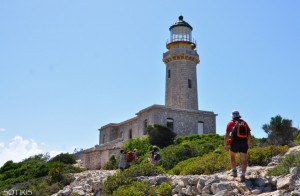 In the centre of the island there is a plateau covered by orange-yellow rocks, which was formed by deposits of vast amounts of pollen over thousands of years. This plateau is named Spartolakka and is a substantial source of information for scientists regarding the dating of the forest and the surrounding area. The famous “Well of Oinousses” is located on the southwest side of the island and is actually the deepest point in the Mediterranean at 5,121 metres.
In the centre of the island there is a plateau covered by orange-yellow rocks, which was formed by deposits of vast amounts of pollen over thousands of years. This plateau is named Spartolakka and is a substantial source of information for scientists regarding the dating of the forest and the surrounding area. The famous “Well of Oinousses” is located on the southwest side of the island and is actually the deepest point in the Mediterranean at 5,121 metres.
 The island has a lovely, well-protected beach, named Ammos, which is located on its northern part and is easily accessible. Findings and traces of shipwrecks were also found on the northern tip of Sapientza and at a shallow depth. The most important one includes the columns from the Grand Peristyle from Caesarea of Palestine, dating back to the first century AD. This exact location, named Cape Karsis, attracts many keen divers due to the interest of the seabed.
The island has a lovely, well-protected beach, named Ammos, which is located on its northern part and is easily accessible. Findings and traces of shipwrecks were also found on the northern tip of Sapientza and at a shallow depth. The most important one includes the columns from the Grand Peristyle from Caesarea of Palestine, dating back to the first century AD. This exact location, named Cape Karsis, attracts many keen divers due to the interest of the seabed.
Source: www.mythicalpeloponnese.gr
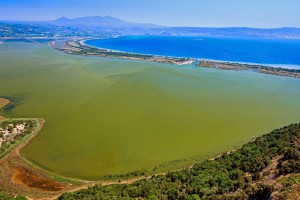 Gialova lagoon is located in Messinia and is one of the most important wetlands not only in Greece, but also in Europe. It probably dates to prehistoric times and owes its creation both to tectonic activity and to a rise in sea level, phenomena which created this ecological zone of unique importance.The Gialova lagoon is the first station in the Balkans that the migratory birds from Africa come across; according to the estimates, these birds are 2 billion in number.
Gialova lagoon is located in Messinia and is one of the most important wetlands not only in Greece, but also in Europe. It probably dates to prehistoric times and owes its creation both to tectonic activity and to a rise in sea level, phenomena which created this ecological zone of unique importance.The Gialova lagoon is the first station in the Balkans that the migratory birds from Africa come across; according to the estimates, these birds are 2 billion in number.
 Of the 442 bird species recorded on Greek soil, more than 270 have been recorded in Gialova. Apart from birds, however, the area also hosts an impressive number of mammals, reptiles, amphibians and fish. So, it is no wonder that it should officially be included in the Natura 2000 Network as a Special Protection Area (SPA); it has also been recognized as a Wildlife Sanctuary and an Important Bird Area.
Of the 442 bird species recorded on Greek soil, more than 270 have been recorded in Gialova. Apart from birds, however, the area also hosts an impressive number of mammals, reptiles, amphibians and fish. So, it is no wonder that it should officially be included in the Natura 2000 Network as a Special Protection Area (SPA); it has also been recognized as a Wildlife Sanctuary and an Important Bird Area.
Source: www.mythicalpeloponnese.gr
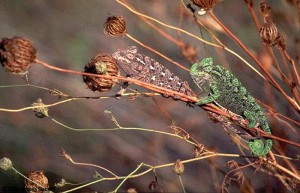 The wetland between the settlement of Gialova and the bay of Voidokilia, which has been declared as an archaeological site, spreads over 6,000 acres of land and is known as Divari (from the Latin vivarium, which means “fish hatchery”); it’s depth does not exceed 4 m. This lagoon is the southernmost stop of the migratory birds of the Balkans travelling to and from Africa. The wetland offers refuge to 254 bird species, such as herons, cormorants, kestrels, Aegean seagulls, flamingos, ospreys, imperial eagles and other aquatic birds. The area also hosts the very rare, almost-extinct in Europe species of the African chameleon.
The wetland between the settlement of Gialova and the bay of Voidokilia, which has been declared as an archaeological site, spreads over 6,000 acres of land and is known as Divari (from the Latin vivarium, which means “fish hatchery”); it’s depth does not exceed 4 m. This lagoon is the southernmost stop of the migratory birds of the Balkans travelling to and from Africa. The wetland offers refuge to 254 bird species, such as herons, cormorants, kestrels, Aegean seagulls, flamingos, ospreys, imperial eagles and other aquatic birds. The area also hosts the very rare, almost-extinct in Europe species of the African chameleon.
Apart from the ferrets, foxes and weasels that hunt its eggs, this serpent is mainly endangered from the overwhelming human presence, especially during the summer months, with the large tourist crowds. The Ornithological Society’s observation station gives the visitors the opportunity to learn and to observe this shallow, brackish-water lake, which has been included in the Natura 2000 network, and to roam around the paths that describe Gialova’s different ecosystems.
The wetland between the settlement of Gialova and the bay of Voidokilia, which has been declared as an archaeological site, spreads over 6,000 acres of land and is known as Divari (from the Latin vivarium, which means “fish hatchery”); it’s depth does not exceed 4 m. The wetland can be divided into brackish-water lagoons and fresh-water marshes. Behind them there is an in-between zone of arable land and maquis. The main human occupations are fishing, cattle breeding, agriculture, tourism and hunting. This lagoon is the southernmost stop of the migratory birds of the Balkans travelling to and from Africa. In the autumn the birds stop here, at the southernmost European wetland, before they fly over the Mediterranean and the Sahara, a journey of 3,000 km. In the spring they follow the reverse route, abandoning their winter homes in Central Africa and migrating to Europe in order to breed.
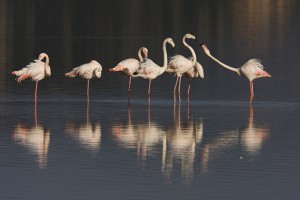 The larger birds, such as the herons, kestrels and Eurasian curlews, arrive at the lagoon in waves during the day and stay only for a few hours, in order to rest. Before dusk, they all fly away together. The smaller birds, such as the charadriiformes, usually arrive at night, stay in the wetland for many hours in order to feed, and most often fly away in the early evening.
The larger birds, such as the herons, kestrels and Eurasian curlews, arrive at the lagoon in waves during the day and stay only for a few hours, in order to rest. Before dusk, they all fly away together. The smaller birds, such as the charadriiformes, usually arrive at night, stay in the wetland for many hours in order to feed, and most often fly away in the early evening.
The birds, migratory and non, include: herons (Ardea purpurea and Ardeola ralloides), Little Egrets (Egretta garzetta), bitterns (Ixobrychis minutus), storks (C. ciconis), ducks (T. tadorna), flamingos (Phoenicopterus ruber), Marsh sandpipers (Tringa stagnatilis), wood sandpipers (Tringa glareola), Pratincoles (Glareola pratincola), gulls (Larus melanocephalus), terns (Gelochelidon nilotica, Sterna albifrons), Gull-Billed Terns (Sterna nilotica), cormorants (Phalacrocorax carbo), egrets (Egretta garzetta), Great Egrets (Casmerodius albus), Glossy ibis (Plegadis falcinellus). Of the 254 species that have been recorded in recent years, 79 have been recognized as endangered in Europe and 4 as endangered worldwide.
The main threats are fishing, the increased saltiness in the fresh-water marshes –as a result of drawing water for agricultural use, both from the surface and from underground– and also hunting and the filling of the wetland with debris. The low agricultural intensification, coupled with intensive fishing, the drawing of underground water and the ever-increasing development in tourist facilities are the biggest threats to the wetland. The area has been nominated as a Special Conservation Area.
 The wetland offers refuge to 254 bird species, such as herons, kestrels, Aegean seagulls, flamingos, ospreys, imperial eagles and other aquatic birds. The area also hosts the very rare, almost-extinct in Europe species of the African chameleon. Apart from the ferrets, foxes and weasels that hunt its eggs, this serpent is mainly endangered from the overwhelming human presence, especially during the summer months, with the large tourist crowds. The passage of vehicles destroys both the vegetation (bushy-ammophilous), which is the species’ main abode, and the nests, which are formed in the sand along the coast. In recent years, a decrease in the animal’s size, a delay in its breeding and egg-laying and a relocation of its nests towards more remote areas has been observed.
The wetland offers refuge to 254 bird species, such as herons, kestrels, Aegean seagulls, flamingos, ospreys, imperial eagles and other aquatic birds. The area also hosts the very rare, almost-extinct in Europe species of the African chameleon. Apart from the ferrets, foxes and weasels that hunt its eggs, this serpent is mainly endangered from the overwhelming human presence, especially during the summer months, with the large tourist crowds. The passage of vehicles destroys both the vegetation (bushy-ammophilous), which is the species’ main abode, and the nests, which are formed in the sand along the coast. In recent years, a decrease in the animal’s size, a delay in its breeding and egg-laying and a relocation of its nests towards more remote areas has been observed.
Gialova (it means “flat coast”) is surrounded by olive and citrus trees, as well as gardens and vines that flourish in damp soil. It is a touristically developed area which satisfies the requirements for modern vacations, with its sandy beach pulsating with life, especially during the summer months, something that at the same time becomes the most immediate danger for the survival of the wetland. Not very far, the waves of the Ionian sea created a unique part of the ecosystem, the impressive for its shape, colours, sandy beach and emerald green waters bay of Voidokoilia, one-of-its-kind in the whole of the Mediterranean. The cedars and the sand dunes protect the ground and the sand is preserved, despite the strong winds blowing in the bay. From above it resembles a sea mushroom, with a dark blue jellyfish peeking through its waters.
The Ornithological Society’s observation station gives the visitors the opportunity to learn and to observe this shallow, brackish-water lake, which has been included in the Natura 2000 network, and to roam around the paths that describe Gialova’s different ecosystems.
Source: www.mythicalpeloponnese.gr
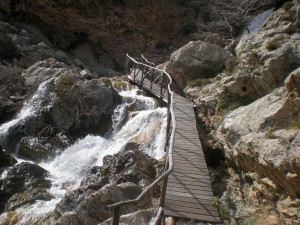 The gorge of Lepida is one of the numerous, impressive natural formations of Mount Parnon, which stands between the prefectures of Arcadia and Laconia. Its length is 500 metres and it is relatively flat. Two hours are required to cross it, during which visitors will have the opportunity to enjoy the unique natural beauty of the landscape, which is filled with rich flora and fauna and boasts two gorgeous waterfalls (ideal for rappel), of 45 and 70 metres respectively, which complement the impressive scenery.
The gorge of Lepida is one of the numerous, impressive natural formations of Mount Parnon, which stands between the prefectures of Arcadia and Laconia. Its length is 500 metres and it is relatively flat. Two hours are required to cross it, during which visitors will have the opportunity to enjoy the unique natural beauty of the landscape, which is filled with rich flora and fauna and boasts two gorgeous waterfalls (ideal for rappel), of 45 and 70 metres respectively, which complement the impressive scenery.
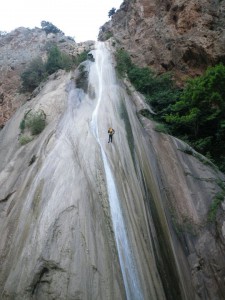 Access to the gorge is possible via the villages of Kato Doliana and Kastritohoria. Crossing is safer during the summer when the level of the waters is low, and this can also be combined with visits to notable attractions, such as Tiryntha, Akronafplia and Mycenae. There are also several lovely beaches close by.
Access to the gorge is possible via the villages of Kato Doliana and Kastritohoria. Crossing is safer during the summer when the level of the waters is low, and this can also be combined with visits to notable attractions, such as Tiryntha, Akronafplia and Mycenae. There are also several lovely beaches close by.
Source: www.mythicalpeloponnese.gr
Lousios is a Peloponnesian river and a tributary of Alfeios. It is a relatively small river, approximately 25 kilometres long. However the landscape that surrounds it on its both banks is magical. The name of the river has ancient origins. It is said that it was given this name because the newborn Zeus was bathed (Louzo=bathing) in its waters by the nymphs Theisoa, Neda and Agno.
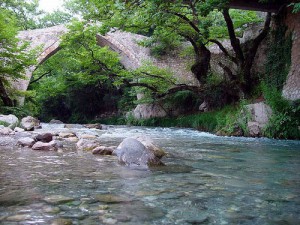 Near Karytaina, River Lousios crosses a gorge of substantial environmental importance, about 26 kilometres from its mouth. The natural beauty of this gorge fully justifies its characterization as a protected zone by the Ministry of Culture in 1997. Its flora is rich, and its fauna includes many species of reptiles, birds and even bats. There are numerous monasteries, churches and hermitages around the river, evidence of the religious life that developed there in the past.
Near Karytaina, River Lousios crosses a gorge of substantial environmental importance, about 26 kilometres from its mouth. The natural beauty of this gorge fully justifies its characterization as a protected zone by the Ministry of Culture in 1997. Its flora is rich, and its fauna includes many species of reptiles, birds and even bats. There are numerous monasteries, churches and hermitages around the river, evidence of the religious life that developed there in the past.
The gorge is ideal for a plethora of activities, like rafting and kayaking. It is a particularly impetuous river and is certainly not recommended for beginners. However, the crossing of the gorge is something suitable for everyone and a truly unique experience.
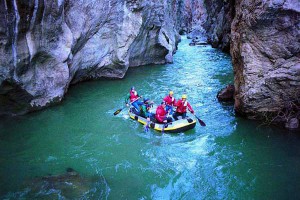 Lousios originates in the location of the ancient town of Theisoa, near the village of Karkalou, as well as further to the north, near Kaloneri, in the location of the church of Agia Paraskevi. These two streams meet up in Karkalou, where Lousios continues its course, to end up after 25 kilometres in Alfeios and flow into somewhere near Karytaina. In its relatively short course, Lousios gives life to the entire surrounding area and dazzles with its natural beauty that includes flora, fauna, unique formations, waterfalls and an incredible gorge.
Lousios originates in the location of the ancient town of Theisoa, near the village of Karkalou, as well as further to the north, near Kaloneri, in the location of the church of Agia Paraskevi. These two streams meet up in Karkalou, where Lousios continues its course, to end up after 25 kilometres in Alfeios and flow into somewhere near Karytaina. In its relatively short course, Lousios gives life to the entire surrounding area and dazzles with its natural beauty that includes flora, fauna, unique formations, waterfalls and an incredible gorge.
 The gorge of River Lousios is one of the most impressive attractions in the prefecture of Arcadia. It is 15 kilometres long and around 2 kilometres wide. On its western side it goes through the National Trail 32, which is part of the European trail E4 GR that starts from Vytina, passing through the villages of Zygovisti, Dimitsana and Paliohori, the Monasteries of Philosophou and St. John the Baptist, then through Karytaina to end up in Gytheio. This entire area is truly amazing. The flora is rich and includes laurels, maples, willows, yews, myrtles, plane trees, elms, poplars, firs, olive trees and many more. The fauna is equally impressive, including various species of reptiles, birds, fish and mammals that live here throughout the year.
The gorge of River Lousios is one of the most impressive attractions in the prefecture of Arcadia. It is 15 kilometres long and around 2 kilometres wide. On its western side it goes through the National Trail 32, which is part of the European trail E4 GR that starts from Vytina, passing through the villages of Zygovisti, Dimitsana and Paliohori, the Monasteries of Philosophou and St. John the Baptist, then through Karytaina to end up in Gytheio. This entire area is truly amazing. The flora is rich and includes laurels, maples, willows, yews, myrtles, plane trees, elms, poplars, firs, olive trees and many more. The fauna is equally impressive, including various species of reptiles, birds, fish and mammals that live here throughout the year.
Religious and ascetic life developed on both sides of the gorge, especially during the Turkish occupation; something obvious from the existence of numerous monasteries, churches and hermitages, like the monasteries of Aimyaloi, Kalamiou, Philosophou, St. John the Baptist and the church of Agios Andreas of Gortyna. The wild beauty of the area combined with the serenity of nature were ideal for anyone who wanted to feel closer to God.
The gorge of River Lousios is perfect for many activities, like canyoning (crossing the river by various means), canoe-kayak, rafting, hiking and trekking. The hiking trails are numerous, each one with something different to offer. In 1997 the gorge was declared as an area of particular archaeological and environmental importance and was placed under the auspices of the Ministry of Culture.
Source: www.mythicalpeloponnese.gr
Thermisia lagoon is an important habitat of rare migratory birds. It is a serene and unique lagoon surrounded by a breathtaking landscape.
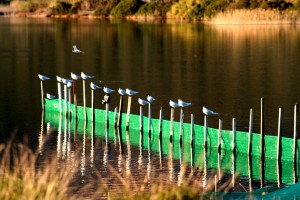 Located in the picturesque village of Thermisia, to the east of Ermioni, the lagoon took its name from some hot springs that existed in the area. The Greek traveler Pausanias mentions a temple dedicated to Demeter Thermasia. This magnificent lagoon was used as a salt lake during the Venetian occupation and in modern times it hosted fish hatcheries. Today, it is of one of the most significant habitats in the region and it has been integrated in national and international protection networks; namely the European network CORINE BIOTOPS. The rare species that seek refuge in the site are protected under the European directive 79/409 and the Bern Convention.
Located in the picturesque village of Thermisia, to the east of Ermioni, the lagoon took its name from some hot springs that existed in the area. The Greek traveler Pausanias mentions a temple dedicated to Demeter Thermasia. This magnificent lagoon was used as a salt lake during the Venetian occupation and in modern times it hosted fish hatcheries. Today, it is of one of the most significant habitats in the region and it has been integrated in national and international protection networks; namely the European network CORINE BIOTOPS. The rare species that seek refuge in the site are protected under the European directive 79/409 and the Bern Convention.
Thousands of rare migratory birds visit the lagoon every year; herons, Gull-billed Terns (Gelochelidon nilotica), starlings (Sturnus vulgaris), glossy ibis (Plegadis falcinellus), the great egret (Egretta alba) and numerous other species.
Source: www.mythicalpeloponnese.gr

